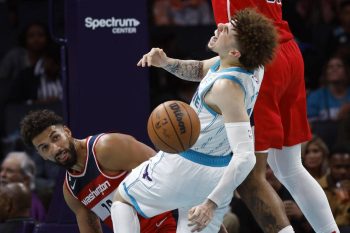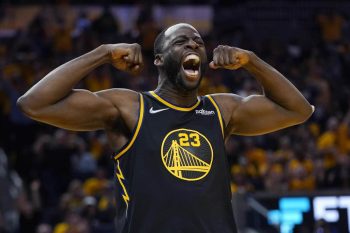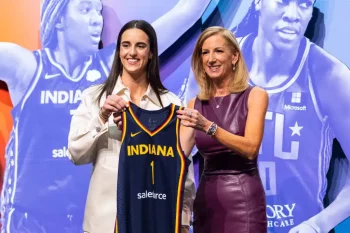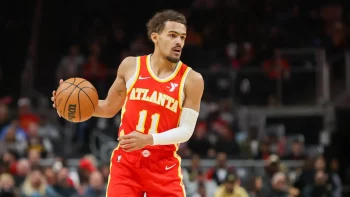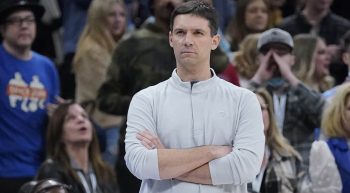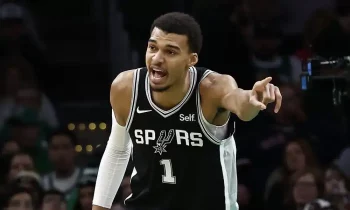NBA
Fixing the Denver Nuggets

The Denver Nuggets are an interesting team. They are currently 34-44 and 11th in the Western Conference. This is not the way this season was supposed to go after the Nuggets secured the third seed in the Western Conference last year. However, some key changes from last season’s team set the groundwork for a letdown season.
During this past offseason, the Nuggets fired long-time head coach George Karl even though Karl had just won Coach of the Year. Then, the Toronto Raptors managed to pluck away the Nuggets’ general manager, Masai Ujiri, who had just won Executive of the Year. The Nuggets hired Brian Shaw, who had no prior head coaching experience, to replace Karl. Shaw had long been considered an up-and-coming assistant coach who would inevitably be hired as a head coach. Tim Connelly was then named the new general manager to replace Ujiri.
However, the changes were not only in the front office. Lock-down wing-defender Andre Iguodala, who had been acquired by the Nuggets in 2012 in the four-team megadeal centered around Dwight Howard, was traded to the Golden State Warriors in a sign-and-trade deal. The Nuggets received Randy Foye and a trade exception of $9,868,632, which expires in July.
These front office and roster shake-ups set the table for a potentially disappointing season, but nothing has derailed the Nuggets more than injuries. Danilo Gallinari tore his ACL last season and underwent a conservative operation to avoid a complete reconstruction of the ligament. That approach failed and it was announced in January that Gallinari would miss the entire season to undergo the full operation. JaVale McGee missed all but five games this season due to a stress fracture in his leg that required surgery. Nate Robinson and J.J. Hickson each tore their ACL. Wilson Chandler has missed significant time, most recently to a groin and hip injury. On top of the injuries, Andre Miller clashed with Shaw and elected to remove himself from the team and was eventually traded to the Washington Wizards.
With all of this in mind, the Nuggets have a few options as to how to move forward and bounce back from this disappointing season.
Make Ty Lawson and Kenneth Faried the Cornerstones of the Franchise
Shaw recently told NBA.com that he sees Lawson and Faried as “the cornerstones that this team is going to be built around.” There is little doubt that these are the two most valuable players on the team, and it will serve the Nuggets well to base their roster moves around them.
Lawson is sometimes lost in the glut of star point guards that are currently in the NBA. Make no mistake though, Lawson is one of the best, averaging 8.8 assists a game, the second most in the league behind only Chris Paul. Lawson also averages 17.6 points and 3.5 rebounds, and shoots 35.6 percent from beyond the arc.
Lawson is one of the quickest players in the league and uses that speed effectively. He attempts 10.6 drives to the rim per game, which is the most in the league. He shoots 50.7 percent on these drives, which puts him in the same ballpark as elite finishers like Tony Parker, who drives to the rim 10.1 times per game and shoots 53.1 percent. By getting to the rim, Lawson forces defenses to make quick rotations, which is ideal when you have someone as active as Faried hovering around the paint waiting to swallow up rebounds and score on put backs.
Lawson isn’t perfect, however. His small stature makes it difficult for him to guard lengthy opposing guards. In spite of this limitation, Lawson is made to push the tempo in Denver’s high altitude, especially alongside Faried.
Faried has always been tagged as an energy guy, which can be interpreted as a back-handed compliment. However, since the All-Star break and trade deadline, Faried has shown some new dynamics to his game, and increased production. Since late February, Faried has averaged 18.4 points, 9.6 rebounds, 1.6 assists and 1.1 steals per game. He is posting up more, and scoring effectively. He is now showing that he is in fact more than an energy player, and someone the Nuggets can build around.
»In Related: One on One With Kenneth Faried
Perhaps most important, Faried and Lawson fit together. Lawson is a blur in the open court and aside from maybe Blake Griffin, no big in the league runs the floor like Faried. When the two leak out in transition, they put a ton of pressure on the opposing team’s defense.
“With Ty, it’s a little bit like a marriage,” Faried told Grantland. “If you don’t have chemistry and love being around your partner, it’s not gonna work. But we have great chemistry. We can yell at each other and still be friends.”
Couple this existing transition attack with Faried’s new-found ability to score in post-up situations, and it becomes clear why the Nuggets should move forward with these two players as the team leaders.
Having said that, Lawson and Faried are both on the smaller side for their positions, which creates inherent defensive limitations. This should not be ignored, and it will be up to Shaw to find ways to come up with defensive schemes that can address this moving forward.
Also, Faried’s contract situation is still in flux. The Nuggets shopped Faried earlier this season in search of a first-round draft pick and young wing player, such as Iman Shumpert of the New York Knicks. The Nuggets were looking to acquire young assets using Faried, showing their hesitation to offer the big man a large contract extension. Given Faried’s recent play, however, the Nuggets should not shy away from offering him a multi-year extension ranging from $8 million to $11 million.
Don’t Blow-up the Team
As bad as this season has been for Denver, the fact remains that they have a lot of talent that missed significant time this year. Before his injury last year, Gallinari was scoring 16.2 points per game and hitting 37.3 percent of his three-point attempts. He also averaged 2.5 assists and 5.2 rebounds per game. Most importantly, Gallinari is creative with the ball, and is a match-up problem for most teams. His ability to stretch the floor and make surprisingly accurate passes has been sorely missed throughout this season.
The problem is that Gallinari originally tore his ACL on April 4, 2013, but underwent a conservative operation to repair it without a complete reconstruction, which ultimately failed. He ended up having a complete reconstruction of the ACL on January 21 of this year, which has significantly set back his timetable for a return. ACL tears tend to require anywhere from nine months to over a year to fully recover, and there can be issues even after that. Still, Gallinari is the sort of player that can have a major impact beyond filling up the stat sheet and when he returns it will make a huge difference for the Nuggets.
Chandler has also been missed at times. Though he was more efficient last season, Chandler still managed to chip in 14 points a game in 59 games this season. He also contributed 4.8 rebounds and 1.8 assists and is another forward who can stretch the floor with his shooting. Chandler has consistently dealt with injuries throughout his career, but if he can play close to 70 games next season, it will be a huge boost for the Nuggets.
Lastly, the Nuggets should not give up on McGee. Patience for McGee has run thin throughout the league due to his inconsistent production and absentminded plays that often end up on TNT’s segment “Shaqtin’ A Fool.” But it is not time to give up on the young center. Shaw needs to follow the Doc Rivers approach and instill a defensive mindset in McGee. Many fans in Los Angeles were ready to move DeAndre Jordan for pennies on the dollar, but Rivers has managed to turn Jordan into a fringe Defensive Player of the Year candidate this season. If Shaw can get McGee to focus solely on rebounding, anchoring the defense, making timely defensive rotations and using his quickness to disrupt ball handlers on pick-and-rolls, he will become a great fit next to Faried the same way Jordan is to Blake Griffin. Timofey Mozgov has improved defensively, but he and Faried have been underwhelming as defenders while on the court together.
There may be a temptation to trade these players to shake things up, but the Nuggets should resist. Of course, if there is a lopsided deal available, they should take it. But these are talented players and shouldn’t be moved just for the sake of change. If the Nuggets do want to start from scratch, they can simply wait until 2016-17, when all current contracts will expire, except for Lawson and maybe Faried (if his contract is extended).
»In Related: Denver Nuggets Salary Cap Info
Slow Down… But Just a Little
In 2012-13, the Nuggets had the second-fastest pace and fifth-most efficient offense in the league. That team included several players that are still with the team, including Chandler, Faried, Gallinari, Lawson, McGee, Mozgov and Evan Fournier. Some notable players who are now gone include Iguodala, Miller, Corey Brewer and Jordan Hamilton.
Despite losing Brewer and Iguodala, the Nuggets still have the means to score points in transition as well as any other team in the league. Think of Chris Paul, Blake Griffin and DeAndre Jordan in transition. Lawson, Faried and a healthy McGee (the only center in the league more athletic than Jordan) could be just as effective as the Clippers are in the open court. Recently acquired point guard Aaron Brooks has played well recently too, and should be retained by the Nuggets if he signs for an affordable price. But beyond the athletes, Denver has the well-noted altitude advantage. Denver is a tough place to play for opposing players because they need to adapt to the high altitude, which causes fatigue early in games. This is especially true when teams are coming into Denver after playing the previous night against another team. The Nuggets need to continue to utilize this unique advantage.
There is a common sentiment that fast-paced teams will be at a disadvantage in the playoffs, where the game is said to slow down and half-court execution is the key to winning. As true as this may be, the fact is that the majority of teams now run some variation of a transition game, including the Rockets, Clippers, Suns, Warriors, Thunder, Blazers and Spurs. These teams will not abandon this tactic once the playoff starts either. The Clippers, Rockets and Spurs – all in the top-five in offensive efficiency – score points in transition, but more importantly are able to score in half-court sets by utilizing quick ball movement, spreading the floor with shooters, utilizing a post-player, running consistent pick-and-rolls and running wings off screens to create weak-side movement.
The Nuggets are currently third in the NBA in pace, right behind the Philadelphia 76ers and Los Angeles Lakers. It will be beneficial to the Nuggets to move closer to the 5-to-10 range in terms of pace, where some of the best offensive teams currently stand and implement motion-based half-court sets. This will allow them to benefit from their advantage at home, and prepare them for the playoffs.
Develop the Young Nucleus
The Nuggets currently have some intriguing young players that can be solid contributors moving forward. Fournier has an intriguing overall skill-set. Per 36 minutes, Fournier is averaging 15.1 points, 2.7 assists, 4.9 rebounds, and is shooting 39 percent from the beyond the arc. He may not be ready to be a full-time starter at shooting guard, but Denver should continue to give him minutes behind Foye to develop him further. Quincy Miller has also shown some promise recently, scoring 19 points and hitting 3-of-5 shots from beyond the arc against the Rockets on April 6.
In addition, Jan Vesley has showcased a developed defensive game recently. Vesley struggles to guard opposing bigs in the post, but has shown a good understanding of how to defend against pick-and-rolls and when to rotate to the weak side. Vesley is not under contract for next season, but with Hickson injured, it is worthwhile to sign him at a reasonable rate and give him minutes to develop his offensive game, and see how big of a contributor he can be long-term. This is important, especially if Darrell Arthur decides to opt out of his contract and find a new team through free agency. The Nuggets should also look to bring over overseas prospect Joffrey Lauvergne, who has made major strides this year. Lauvergne is a power forward with a nice shooting touch, and could be used as a stretch-four.
Also, the Nuggets will have a first-round pick in this year’s draft. The Nuggets could use another shooter, and they should keep an eye on Zach Lavine out of UCLA, who has notable athleticism and upside, which makes him a good fit in Denver. He is a lengthy player who would fit nicely next to Lawson, and could do some ball-handling as well, which would allow Lawson to work off the ball occasionally. Another intriguing player could be Tyler Ennis, who could backup Lawson and provide more length at the point guard position.
Developing young players is an effective strategy that teams like the Oklahoma City Thunder utilize. It provides a young nucleus of players to call on when veteran players are injured and makes them more valuable to teams in trade negotiations. For example, if Kevin Love is put on the market next season, the Nuggets could offer players like Fournier, Miller, Vesley, Lauvergne, Faried, Chandler and future draft picks. If the younger players have showcased their developmental progress enough, they could supplement Faried and Chandler and create an intriguing package of assets for Minnesota to consider. However, trading for a player like Love is risky given his contract situation, and Denver would need to get some assurance that Love had a strong interest in signing with Denver long-term.
The Nuggets are in an enviable position. They have solid talent on the roster, and it is just a matter of time before the injured players make their return to the court. The Nuggets should push forward with these players, give minutes to the young talent to slowly bring them along, and be opportunistic if a talent like Love becomes available. The main reason this approach works is because in 2016-17, the only player under contract, as of now, is Ty Lawson (the Nuggets can also extend a qualifying offer to Fournier). This means that if this group of players cannot contend at a high level, there is a reset button coming in 2016-17. With this in mind, the Nuggets should push forward with this current group, and avoid adding on any significant contracts that go beyond 2015-16. This way the Nuggets can start over with players like Lawson and Faried, and build through the draft like so many teams do these days.
